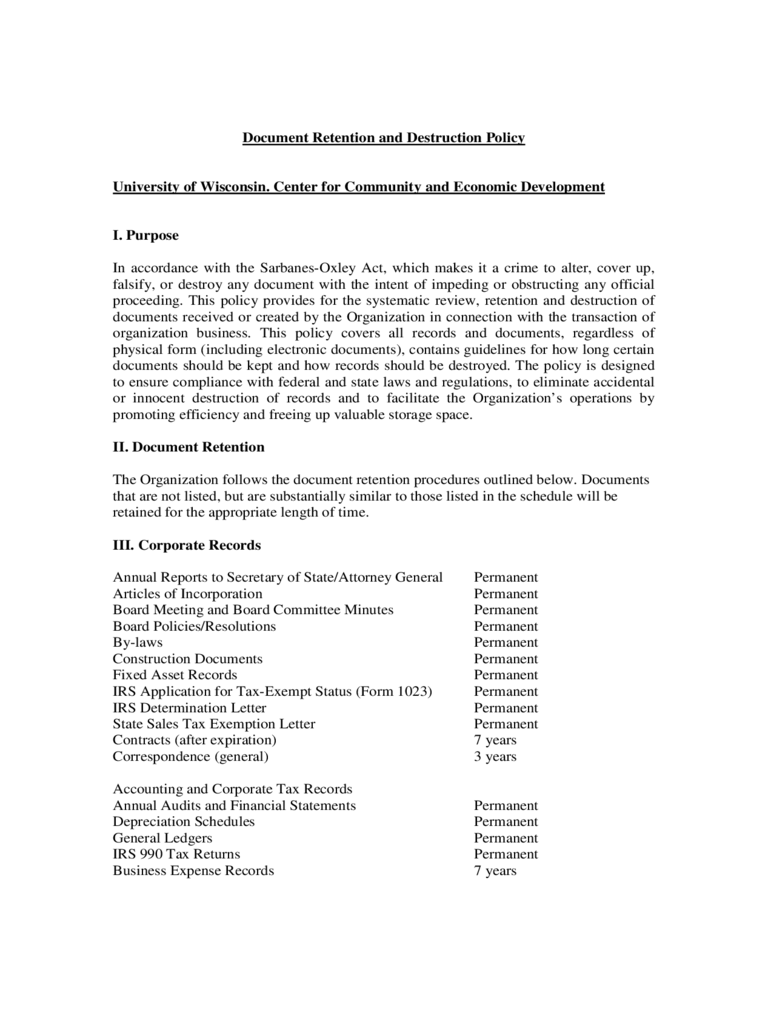Fillable Printable Sample Document Retention and Destruction Policy
Fillable Printable Sample Document Retention and Destruction Policy

Sample Document Retention and Destruction Policy

Document Retention and Destruction Policy
University of Wisconsin. Center for Community and Economic Development
I. Purpose
In accordance with the Sarbanes-Oxley Act, which makes it a crime to alter, cover up,
falsify, or destroy any document with the intent of impeding or obstructing any official
proceeding. This policy provides for the systematic review, retention and destruction of
documents received or created by the Organization in connection with the transaction of
organization business. This policy covers all records and documents, regardless of
physical form (including electronic documents), contains guidelines for how long certain
documents should be kept and how records should be destroyed. The policy is designed
to ensure compliance with federal and state laws and regulations, to eliminate accidental
or innocent destruction of records and to facilitate the Organization’s operations by
promoting efficiency and freeing up valuable storage space.
II. Document Retention
The Organization follows the document retention procedures outlined below. Documents
that are not listed, but are substantially similar to those listed in the schedule will be
retained for the appropriate length of time.
III. Corporate Records
Annual Reports to Secretary of Stat e/At t orney General Permanent
Articles of Incorporation Permanent
Board Meeting and Board Committee Minutes Permanent
Board Policies/Resolutions Permanent
By-laws Permanent
Construction Documents Permanent
Fixed Asset Records Permanent
IRS Application for Tax-Exempt Status (Form 1023) Permanent
IRS Determination Letter Permanent
State Sales Tax Exemption Letter Permanent
Contracts (after expiration) 7 year s
Correspondence (general) 3 year s
Accounting and Corporate Tax Records
Annual Audits and Financial Statements Permanent
Depreciation Schedules Permanent
Gener al Led ge rs Permanent
IRS 990 Tax Returns Permanent
Business Expense Records 7 year s
IRS 1099s 7 year s
Journal Entries 7 year s
Invoices 7 year s
Sales Records (box office, concessions, gift shop) 5 year s
Petty Cash Vouchers 3 yea rs
Cash Receipts 3 year s
Credit Card Receipts 3 year s
Bank Records
Check Registers Permanent
Bank Deposit Slips 7 year s
Bank Statements and Reconciliation 7 year s
Electronic Fund Transfer Documents 7 year s
Payroll and Employment Tax Records
Payroll Registers Permanent
State Unemployment Tax Records Permanent
Earnings Records 7 year s
Garnishment Records 7 year s
Payroll Tax returns 7 year s
W-2 Statements 7 year s
Employee Records
Employment and Termination Agreements Permanent
Retirement and Pension Plan Documents Permanent
Records Relating to Promotion, Demotion or Discharge 7 years after termination
Accident Reports and Worker’s Compensation Records 5 year s
Salary Schedules 5 year s
Employment Applications 3 year s
I-9 Forms 3 years after termination
Time Cards 2 year s
Donor Records and Acknowledgement Letters 7 year s
Grant Applications and Contracts 5 years after completion
Legal, Insurance and Safety Records
Appraisals Permanent
Copyright Registrations Permanent
Environmental Studies Permanent
Insurance Policies Permanent
Real Estate Documents Permanent
Stock and Bond Records Permanent
Trademark Registrations Permanent
Leases 6 years aft er ex p irat i on
OSHA Documents 5 year s
General Contracts 3 years after termination
IV. Electronic Documents and Records
Electronic documents will be retained as if they were paper documents. Therefore, any
electronic files, including records of donations made online, that fall into one of the
document types on the above schedule will be maintained for the appropriate amount of
time. If a user has sufficient reason to keep an email message, the message should be
printed in hard copy and kept in the appropriate file or moved to an “archive” computer
file folder. Backup and recovery methods will be tested on a regular basis.
V. Emergency Planning
The Organization’s records will be stored in a safe, secure and accessible manner.
Documents and financial files that are essential to keeping the Organization operating in
an emergency will be duplicated or backed up at least every week and maintained off site.
VI. Document Destruction
The Organization’s Executive Director is responsible for the ongoing process of
identifying its records, which have met the required retention period and o verseein g their
destruction. Destruction of financial and personnel-related documents will be
accomplished by shredding.
Document destruction will be suspended immediately, upon any indication of an
official investigation or when a lawsuit is filed or appears imminent. Destruction will
be reinstated upon conclusion of the investigation.
VII. Compliance
Failure on the part of employees or contract staff to follow this policy can result in
possible civil and criminal sanctions against the Organization and its employees or
contract staff and possible disciplinary action against responsible individuals. The
Treasurer will periodically review these procedures with legal counsel or the
organization’s certified public accountant to ensure that they are in compliance with new
or revised regulations.



